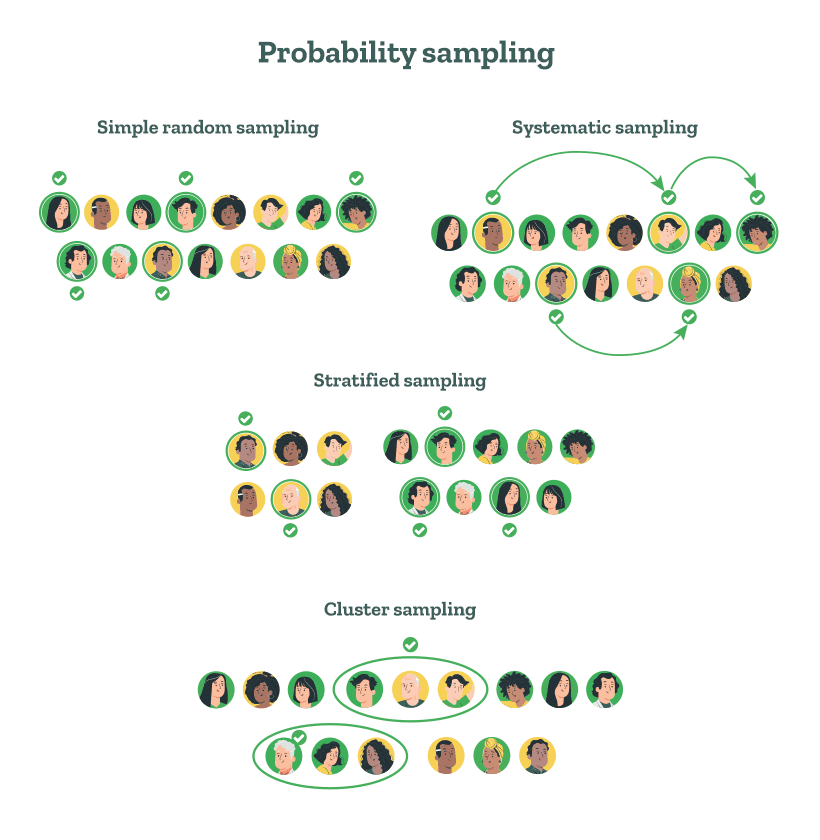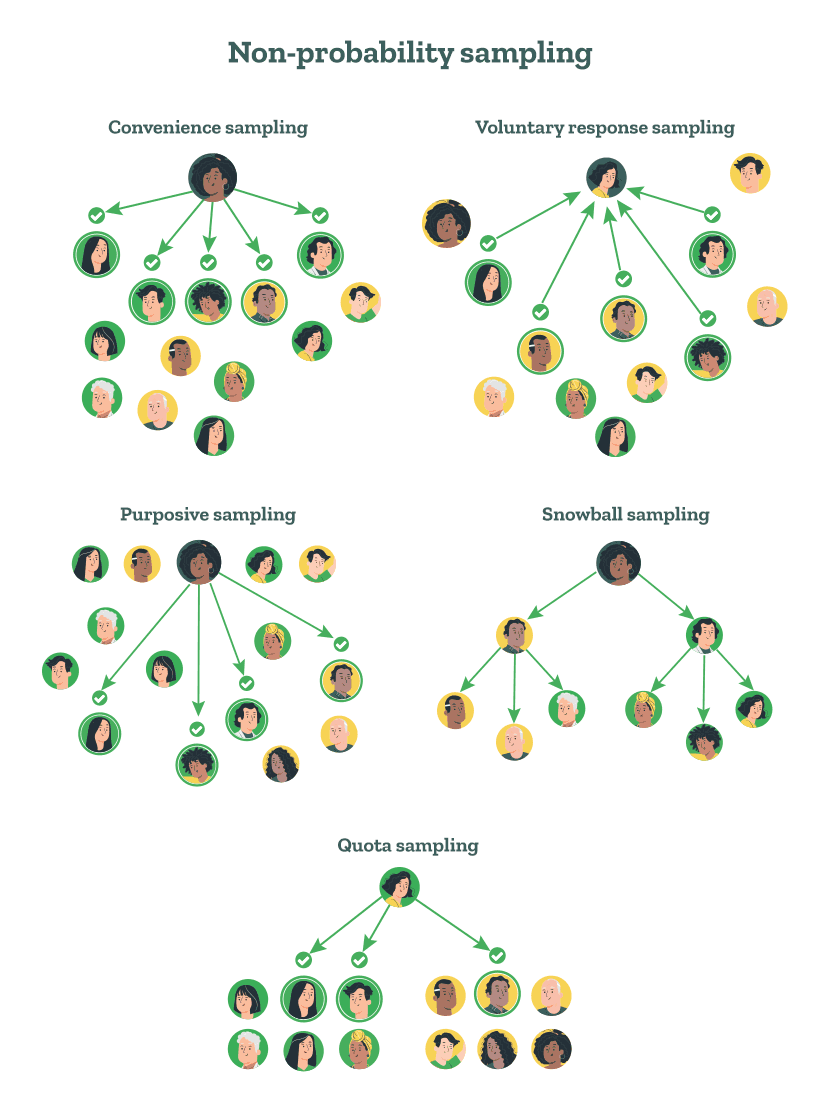Still have questions? Leave a comment

Checklist: Dissertation Proposal
Enter your email id to get the downloadable right in your inbox!

Examples: Edited Papers
Enter your email id to get the downloadable right in your inbox!
Need
Editing and
Proofreading Services?

Sampling Methods Guide: Types, Strategies, and Examples
 Apr 11, 2024
Apr 11, 2024 10
min read
10
min read
- Tags: Academic Research, Research
Welcome to our comprehensive guide on sampling methods! If you’re curious about how researchers gather data and draw meaningful conclusions, you’ve come to the right place. Sampling is a crucial aspect of research and data analysis, allowing us to select a subset of individuals or elements from a larger population.
It is also very important to mention the sampling strategy that you use, in your research methodology section. In this guide, we’ll explore different sampling methods, and strategies, and provide real-life examples to help you understand and apply these techniques effectively!
In this article, we will be looking at:
- What are sampling methods?
- Advantages of using sampling methods
- Difference between population and sample
- Sampling strategies and types
What are sampling methods?
Sampling methods are techniques used by researchers to select a smaller group of individuals or elements from a larger population. It’s like taking a small portion of something to represent the whole. Sampling methods help researchers collect data more efficiently and cost-effectively.
They allow us to study a subset of the population and draw meaningful insights without having to survey or observe every single individual or element. So, in a nutshell, sampling methods are tools that researchers use to choose a representative group from a larger population, making it easier to study and draw conclusions about the whole.
Sampling Frame
A sampling frame is a list or database of all the members of a population from which a sample can be drawn. The sampling frame is crucial because it helps ensure that every member of the population has a chance of being selected for the sample.
For example: Imagine you want to conduct a survey about the favorite ice cream flavors among students in your school. To do this, you need a list of all the students enrolled in the school. This list is your sampling frame. From this sampling frame, you can then select a subset of students who will participate in your survey. This subset is your sample.
Advantages of using sampling methods
Using sampling techniques in research and statistics offers several advantages. Here are some of the key benefits:
1. Efficiency: Sampling saves time and resources compared to studying an entire population.
2. Cost-effectiveness: Collecting data from a smaller group reduces expenses.
3. Feasibility: Sampling makes research possible when studying large or inaccessible populations.
4. Accuracy: Well-designed samples provide representative data for drawing valid conclusions.
5. Timeliness: Sampling enables faster data collection and analysis for timely decision-making.
6. Detailed information: Focusing on a smaller sample allows for more comprehensive data collection.
7. Flexibility: Different sampling techniques accommodate various research needs and populations.
Difference between population and sample

A population is the entire group of individuals, objects, or events that you want to study or make conclusions about. It includes all members of a defined group.
On the other hand, a sample is a smaller subset of the population that is selected for study. It is a portion of the population that is used to represent the entire group.
For example:
Imagine you have a big jar full of candies of different colors. The jar with all the candies is the population. If you take a handful of candies from the jar, that handful is your sample. You can use the sample to make estimates or draw conclusions about the characteristics of all the candies in the jar (the population) without having to examine each and every candy.
In research and statistics, various types of sampling methods are used because it is often impractical, time-consuming, or impossible to study the entire population. By studying a representative sample, researchers can make inferences and generalizations about the larger population.
Sample size
A sample size refers to the number of individuals or observations included in a sample, which is a subset of the entire population being studied.
For example: Imagine you have a bag containing 100 marbles of different colors. The bag with all the marbles is your population. Now, you want to estimate the proportion of blue marbles in the bag. You reach into the bag and randomly pick out 10 marbles. The number of marbles you picked (10) is your sample size. Based on the colors of these 10 marbles, you can make an estimate of the proportion of blue marbles in the entire bag.
Sampling strategies and types
Probability sampling
Probability sampling methods are ways to choose a sample from a population in a fair and unbiased manner. These methods make sure that every person or thing in the population has an equal chance of being picked for the sample.
Think of it like a lottery. In a lottery, every ticket has the same chance of being drawn. Similarly, in probability sampling, every individual in the population has the same chance of being selected for the sample.
Types of probability sampling methods

-
Simple random sampling
Let’s start with the basics – simple random sampling. In this method, every individual in the population has an equal chance of being selected for the sample. It’s fair, and unbiased, and ensures that everyone gets a chance at being included.
For example:
To select a sample of 10 students from a class of 50 students, you can use simple random sampling:
a. Number each student from 1 to 50.
b. Use a random number generator or draw numbers from a hat to select 10 numbers.
c. The students corresponding to the selected numbers will be the sample.
d. Every student in the class had an equal probability of being chosen for the sample, and the selection was made randomly.
-
Stratified sampling
Stratified sampling involves dividing the population into distinct subgroups or strata based on certain characteristics. Then, we select a proportional number of individuals from each stratum to form the sample. This method ensures that our sample reflects the diversity within the population and allows for more accurate analysis within each subgroup.
For example:
Imagine you have a box of 100 toys. The box contains three types of toys: 50 cars, 30 dolls, and 20 puzzles. You want to select a sample of 20 toys from the box to estimate the proportion of each type of toy in the entire box.
To do stratified sampling, you would:
a. Divide the toys into three strata (subgroups) based on their type: cars, dolls, and puzzles.
b. Calculate the proportion of each stratum in the sample. Since you want a sample of 20 toys, and the box has 100 toys, you’ll select 20% of each stratum:
Cars: 50 × 20% = 10 cars
Dolls: 30 × 20% = 6 dolls
Puzzles: 20 × 20% = 4 puzzles
c. Randomly select the calculated number of toys from each stratum:
Randomly pick 10 cars from the 50 cars
Randomly pick 6 dolls from the 30 dolls
Randomly pick 4 puzzles from the 20 puzzles
d. Combine the selected toys from each stratum to form your stratified sample of 20 toys.
-
Systematic sampling
In systematic sampling, we start with a random starting point and then select every ‘nth’ individual from the population. This method is relatively easy to implement and provides a representative sample when there’s no specific pattern or order in the population.
For example:
Imagine you have a shelf with 100 books arranged in a row. You want to select a sample of 10 books from the shelf to estimate the average number of pages in all the books.
To do systematic sampling, you would:
a. Determine the sampling interval by dividing the population size by the desired sample size. In this case, 100 books ÷ 10 books = 10.
b. Choose a random starting point between 1 and the sampling interval (10). Let’s say you randomly pick the number 4.
c. Select every 10th book starting from the 4th book until you have a sample of 10 books.
-
Cluster sampling
In cluster sampling, we divide the population into clusters or groups, and instead of selecting individuals, we randomly choose entire clusters to be included in the sample. Cluster sampling can be more cost-effective and time-efficient, especially when dealing with large populations.
For example:
Imagine you are a school administrator, and you want to survey students about their favorite subject. The school has 1000 students divided into 50 classrooms of 20 students each. Instead of surveying all 1000 students, you decide to use cluster sampling.
To do cluster sampling, you would:
a. Define the clusters: In this case, each classroom is a cluster, so there are 50 clusters in total.
b. Randomly select a sample of clusters: Let’s say you decide to select 5 classrooms (clusters) out of the 50. You can use a random number generator or a hat to randomly pick 5 numbers between 1 and 50, corresponding to the classroom numbers.
c. Include all members of the selected clusters in your sample: If the randomly selected classrooms are 3, 12, 27, 35, and 48, you would survey all 20 students in each of these classrooms.
d. Your final sample size would be 100 students (5 classrooms × 20 students per classroom).
Non-probability sampling
In non-probability sampling, the researcher chooses who to include in the sample based on their judgment or what is easy for them, rather than using random selection where everyone has an equal chance.
This means that the sample might not fairly represent the entire population, and the results of the study might not apply to everyone. However, non-probability sampling can still be helpful in some situations and can provide useful information for the researcher.
Types of non-probability sampling methods

-
Purposive sampling
In purposive sampling, we select participants based on specific criteria or characteristics that are relevant to the study. It’s like handpicking individuals who can provide valuable insights and information related to our research objectives. This method is commonly used in qualitative research or when studying a specific subgroup within a population.
For example:
Imagine you are doing a research project on the challenges faced by students with visual impairments in your school. You want to interview some students to get their perspectives and experiences.
To do purposive sampling, you would:
a. Define the specific characteristics or criteria that are important for your study. In this case, you are looking for students who have visual impairments.
b. Purposefully select individuals who meet these criteria. You would reach out to the school’s disability services office or teachers to help identify students with visual impairments who might be willing to participate in your study.
c. Choose the students who you believe will provide the most relevant and valuable information for your research. For example, you might select students from different grade levels or with varying degrees of visual impairment to get a diverse range of perspectives.
d. Continue selecting participants until you have enough information to answer your research questions or until you reach saturation (when new interviews stop providing new insights).
-
Snowball sampling
In snowball sampling, we start with a small number of individuals who meet our criteria and ask them to refer other potential participants. It’s like creating a snowball effect as more participants join the sample. Snowball sampling is often used in studies involving hard-to-reach populations, such as individuals with rare diseases or marginalized communities.
For example:
Imagine you are conducting a study on the experiences of international students at your university. You want to interview some international students to learn about their challenges and successes.
To do snowball sampling, you would:
a. Start with a few initial participants who meet your criteria (in this case, being an international student). These initial participants are often called “seeds.”
b. After interviewing the seeds, ask them to refer other international students they know who might be willing to participate in your study. This is where the “snowball” effect comes in – your sample grows as each participant refers to others.
c. Contact the referred students and invite them to participate in your study. If they agree, interview them and then ask them to refer other international students they know.
d. Continue this process of interviewing and asking for referrals until you have enough participants to answer your research questions or until you stop getting new referrals.
-
Quota sampling
Quota sampling is a non-probability sampling technique that involves selecting individuals based on pre-defined quotas or characteristics. In quota sampling, the researcher identifies specific characteristics or traits that are relevant to the study. These characteristics could be demographic factors like age, gender, occupation, or any other relevant criteria. The researcher then sets quotas for each characteristic, specifying the desired number of participants to be included in each category.
For example:
Imagine you are surveying favorite pizza toppings in your neighborhood. You want to make sure that your sample includes equal numbers of men and women to get a balanced perspective.
To do quota sampling, you would:
a. Define the key characteristics (quotas) that you want to be represented in your sample. In this case, you want equal numbers of men and women.
b. Determine the total sample size you want. Let’s say you want to survey 100 people.
c. Divide the total sample size by the number of quotas to determine how many participants you need for each quota. In this case, you need 50 men and 50 women.
d. Once you have surveyed 50 men, you stop surveying men and focus on finding women to survey until you reach 50 women.
e. Once you have 50 men and 50 women, your quota sample is complete.
-
Convenience sampling
Convenience sampling, also known as accidental or grab sampling, involves selecting individuals who are readily available and easy to include in the sample. However, convenience sampling may introduce bias and may not accurately represent the population as a whole. So, tread carefully when interpreting the results.
For example:
Imagine you are a student doing a project on the reading habits of your classmates. You need to collect data quickly and don’t have a lot of time or resources.
To use convenience sampling, you would:
a. Decide to survey the people who are most accessible and easy for you to reach. In this case, you might choose to survey your friends, classmates sitting near you, or people you see in the library.
b. Approach these people and ask if they are willing to participate in your survey.
c. If they agree, have them complete your survey about their reading habits.
d. Continue surveying people until you feel like you have enough data for your project or until you run out of time.
-
Voluntary response sampling
Voluntary response sampling, also known as self-selection sampling is a non-probability sampling technique where individuals self-select or volunteer to be part of the sample. In voluntary sampling, participants have the freedom to decide whether or not they want to be included in the study.
Researchers typically advertise or make the opportunity to participate known, and individuals who are interested or motivated to be part of the study voluntarily come forward. This type of sampling is commonly used in surveys, online questionnaires, or studies where individuals can choose to participate based on their willingness or interest.
For example:
Imagine you are a researcher interested in studying the experiences of people who have adopted a vegan lifestyle. You want to gather data through an online survey.
To use voluntary sampling, you would:
a. Create an online survey about the experiences of being vegan.
b. Promote the survey through various channels, such as vegan social media groups, and vegan forums, or by asking vegan friends to share the survey link.
c. In your survey promotion, clearly state that you are looking for vegans to voluntarily participate in your study.
d. As people come across your survey invitation, they can choose to click on the link and complete the survey if they are interested and meet the criteria (being vegan).
e. Collect responses from those who voluntarily completed the survey.
Sampling methods play a crucial role in research and statistics, allowing us to gain valuable insights from a smaller subset of the population. By efficiently selecting representative samples, researchers can save time, reduce costs, and still obtain accurate and meaningful results.
So, as you embark on your research journey, remember the power of sampling methods in unlocking valuable insights. And don’t forget to give your work the final polish it deserves with the help of expert editing and proofreading services, like PaperTrue. Happy researching!
Here are some more useful resources for you:






